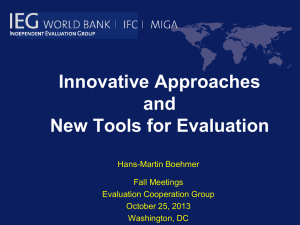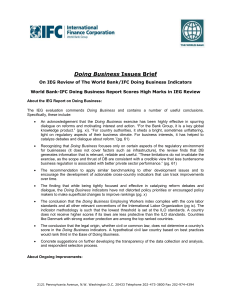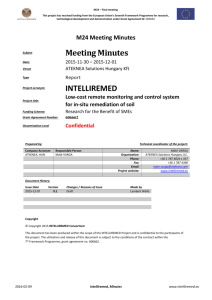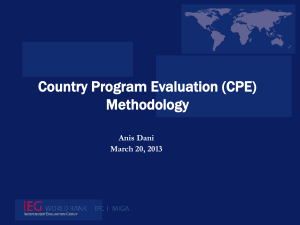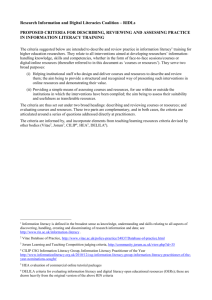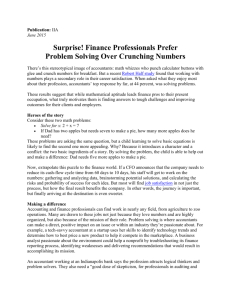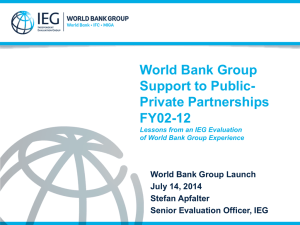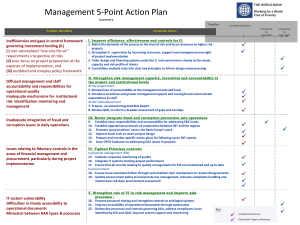The Accounting Curriculum and IT - School of Accounting and Finance
advertisement
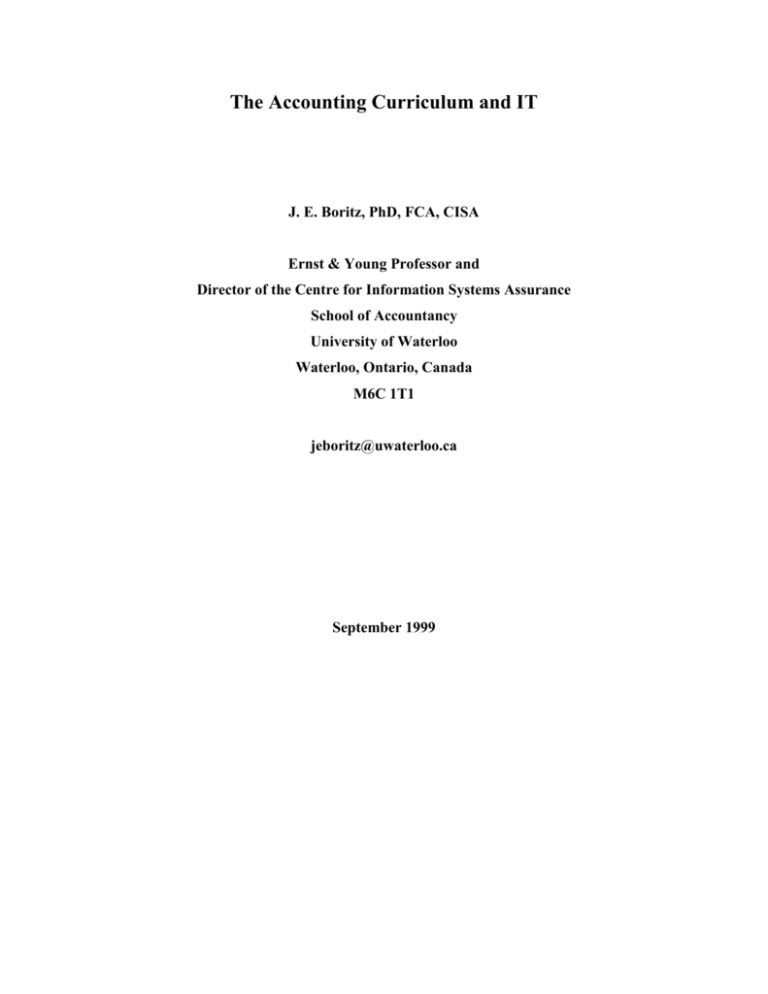
The Accounting Curriculum and IT J. E. Boritz, PhD, FCA, CISA Ernst & Young Professor and Director of the Centre for Information Systems Assurance School of Accountancy University of Waterloo Waterloo, Ontario, Canada M6C 1T1 jeboritz@uwaterloo.ca September 1999 Introduction Great forces are pushing change upon us. We can either respond to this pressure or be overwhelmed by it. This article is about information technology in the accounting curriculum; but information technology is only one of the forces affecting accounting education and it is not isolated in its impact. The major forces affecting accounting education interact with each other, creating a complex decision environment for policy makers everywhere. Therefore, before considering the impact of information technology, let us consider briefly some of the other major trends affecting the accounting profession and, by implication, accounting education: globalization, capital markets, competition, new business models, specialization, and new educational models. Globalization: A pervasive trend that we see around us is globalization. While there are many different views about what globalization means, I look at it as a growing interdependency among communities around the world, including our own community, that of professional accounting. One of the major impacts of globalization on the accounting profession is the movement towards harmonization of practices, standards, and professional qualification programs. There is a growing desire for international reciprocity so professionals who qualify in one jurisdiction are free to practice in another jurisdiction without unreasonable obstacles being placed in their way. This means, however, that less developed regions must operate their education and qualification programs to approximately the standard of the more developed regions. Capital Markets: The growth of international capital markets has been another of the great trends affecting the business community and our profession. Part of the growth of capital markets relates to globalization. However, another great impact of the growth of international capital markets is the emphasis being placed on finance in the accounting curriculum. In the past, this area has not been given sufficient attention in accounting curriculums, but now it is becoming an essential ingredient in the success of professional accountants, both in the public practice arena and in the management accounting arena. 3 Competition: At one time, much of the accountant’s revenue was derived from bookkeeping services, tax return preparation, and preparation and audit of historic financial statements. These old niches are declining in their prominence and importance as revenue sources to most professional accountants. At one time, the accounting profession took advantage of its protected status as a regulated area of economic activity. During the last two decades, this has changed drastically in many countries. There is all manner of deregulation taking place, resulting in great changes in the nature of professional activity. The so-called consolidators who are buying up small practices in the US, such as American Express, Century Business Services and H&R Block, represent the latest wave of competitive pressure affecting the accounting profession. New Business Models: One of the most significant developments in recent times has been the development of new business models involving the breakdown of hierarchical organizations in favour of networks of various partnerships and joint ventures engaged in constantly selfreconstituting entities. These new business models require different styles of management and types of reporting from those that were common in the hierarchical organizations that many of us were accustomed to until now. The new business models have resulted in the need for a whole new set of services aimed at improving the quality of information for decision making or its context, ranging from consulting to attestation and everything in between. One of the significant corresponding changes in the accounting profession has been the growth of the “professional services firms” (formerly, “accounting firms”), competing in many sectors of the economy. Professional services firms derive 60% of their revenue from information technology consulting, and a large part of their revenue from tax consulting. Some professional services firms have within them full service legal firms, and so on. Professional services firms are reshaping the nature of the very profession that gave them life. These changes will be farreaching and it is hard to predict where we will be ten years from now. But one disturbing phenomenon is that the major professional services firms are hiring significantly fewer accounting students, preferring to hire more mature recruits with specific industry experience. In most firms the accountant is a minority. Some academic institutions are addressing this problem by revising their curricula to focus on skills, such as IT skills, that would make their students more attractive to these and other firms. 4 Specialization: With the explosion of competition, new business models and the other trends that I have already mentioned, it has become clear that specialization is essential to effective performance. No single professional can master every field of activity in which a professional services firm is engaged. As a result, many of the professional services firms are organized by business sector. Many of our educational curriculums, however, were designed for a “one size fits all” practitioner. This is no longer adequate to maintain the pre-eminent position of the accounting profession. It is becoming obvious in the business community and in the educational community that students must achieve some type of specialization in order to make them employable. It took several decades for professional bodies around the world to accept the concept of post-qualification specialization. However, the world has moved on, and this is no longer sufficient. As a result, there is a growing recognition that there is a need for not just post-qualification specialization, but pre-qualification specialization as well. New Educational Models: The educational system is going through many changes. In my opinion, the three most important are Internet-based distance education, co-operative education (co-op), and competency-based models. One thing that all of these have in common is their objective of delivering education closer to the workplace, rather than restricting education to educational institutions removed from the realm of practice. Distance education is getting a tremendous boost through the rapid growth in the Internet and related tools for developing sophisticated web-based courses. The global reach of the Internet makes it possible to develop and share courses on a global basis in response to global trends. A co-op educational model is based on the theory of alternating work and study periods during an education program to permit students to apply in the field what they have learned in school and to bring from the field issues to be addressed through in-depth study in an educational context This enables them to see the various stages of the business cycle, and to relate theory to practice and practice to theory. Another advantage of co-op education programs is that they enable students to support themselves economically while engaging in study. The growth of competency-based models is another reflection of the desire to link work-related outcomes to curriculum design, rather than keeping them separate. In concept, competency-based models are tables that relate abilities required in the workplace with the evidence that a student or employee had achieved such abilities. In principle, if the abilities were defined well enough, and the evidence was reliable 5 enough, aspiring professionals could manage their own progress through such a chart of requirements in the context of their own particular work and study environment to satisfy professional qualification criteria. Information Technology: In a now famous article in Accounting Horizons, Bob Elliot, makes the point that "IT changes everything." Indeed it does. Everyone knows about the impact of the Internet on communications and commerce, as well as other aspects of our lives; information technology is one of the great trends of the latter half of the twentieth century, and it is changing everything! Since the publication of International Education Guideline 11 by IFAC’s education committee in 1995, on behalf of the education committee I have been monitoring relevant developments in IT that might have important implications for IEG 11. These monitoring activities led to a number of revisions to IEG 11 in June 1998. My recent monitoring activities suggest that, if anything, recent IT trends indicate that even more urgent attention to the integration of IT into the accounting curriculum for professional accountants is required now than was apparent when the guideline was first developed. Tables 1, 2 and 3 summarize the key knowledge and skill areas identified and discussed in IEG 11. Table 1 lists the general education requirements, corresponding roughly to the equivalent of two one-term courses, that describe the foundation for further IT-related coverage. Table 2 summarizes the user role requirements, corresponding roughly to the equivalent of one one-term course. Table 3 summarizes the designer, manager and evaluator requirements, one of which would be chosen, corresponding roughly to the equivalent of one additional one-term course. In the balance of this article, I plan to summarize the main IT trends affecting accounting practice, education and training. Most of the observations noted here are based on North American data and thus may not be entirely representative of trends in other parts of the world. However, I believe that most aspects of IT are universal and will thus be relevant, sooner or later, in most parts of the world. In addition, as mentioned at the outset, IT trends are not the only significant trends affecting the profession and its educational institutions. Accordingly, any 6 policy-oriented discussion must consider IT trends in light of the other dominant trends identified earlier. Key Information Technology Trends There are many groups and individuals involved in monitoring and forecasting IT developments. For this article I have relied on the work of two key groups, the Gartner Group, a leading computer consulting firm and the American Institute of Certified Public Accountants (AICPA), a member body that devotes considerable resources to keeping abreast of IT developments and disseminating them to its members. The Gartner Group's assessment of the top technologies reflects a broad perspective on IT that is not necessarily focussed on trends affecting the accounting profession. In contrast, the AICPA's perspective tends to be oriented around business-related issues, particularly those with an impact on accountants in public practice, industry and the public sector. According to the Gartner Group, the top technologies for 1999 are Digital Subscriber Line (DSL), Natural Language Information Retrieval, Extranets, Speech Recognition, Internet Telephony, Internet Chat, Biometrics, Electronic Books, Wearable Computers, and Avatars. I have personally used or experimented with many of these technologies and agree with the Gartner Group's assessments of their significance, although we may quibble over some of the rankings. I will briefly describe only three of these technologies. Digital Subscriber Line: Digital Subscriber Line (DSL) is a technology that competes with cable modems in the residential sector. I have been using DSL for about a year at home and have found it to be one of the best investments I have made. Briefly, DSL enables an existing telephone line to become a high-speed data communications channel, resulting in internet browsing performance that is equivalent or superior to the speed of hookups previously available only at large corporations, universities and other entities with dedicated high speed networks. And I still can continue to use that telephone line as I did before, to make phone calls, send faxes and even dial up another Internet account and use it at the same time as I am online with the DSL account. As a result of this feature, my productivity has increased dramatically. I 7 have saved literally hundreds of hours that I previously spent waiting for my web browser to download information from a website. As a result, my usage of the web, particularly features that I previously hesitated to use due to the waiting time involved, has expanded significantly. Speech Recognition: Another feature I have used is speech recognition software. It enables me to dictate drafts of memos, letters and reports directly into my word processing program, eliminating the inefficiencies of the previous method whereby I would dictate a document into a dictaphone, a secretary would transcribe the dictation, I would revise the transcription, the secretary would correct the transcription, and this would go on for a couple of rounds until we got it right, subject to delays caused by other secretarial duties, etc. Now, I can see the dictation appearing on my computer screen as I speak, making the entire process smoother, more flexible, more efficient and more effective. As with the previous example, the result for me is significantly improved flexibility in how and when I prepare documents. Internet Telephony: A third feature that is literally sweeping the world is Internet Telephony. Chat programs like ICQ and AOL’s Instant Messenger enable people to communicate with each other through the Internet in real time, essentially for free. I see students using ICQ to communicate and collaborate with others, linking up in chat rooms as the need or desire arises, in a very natural way. As a result, facilities such as ICQ are literally revolutionizing communications around the globe. Recently, AOL reported that it handles ¾ of a billion messages per day through its Instant Messenger service. This text-based communication is now being extended to voice transmission over the internet. Although the transmission quality is not yet up to the quality of conventional telephone services, it is improving and is much, much cheaper for long distance calls. While I could go on at length about each of Gartner Group's list of key technologies, that is outside the scope of this article. I am merely using these three examples to illustrate that the technologies are significant because they are available today, they are inexpensive to acquire and simple to implement, and they enhance productivity and information exchange dramatically. 8 While the Gartner Group focuses on mass market types of trends, for several years the AICPA has been monitoring and publishing in the Journal of Accountancy information on IT trends of significance to business and accounting. Table 4 summarizes this information for the years 1996-1999 (I have take some liberties in grouping technologies whose names have changed or which have been absorbed by other technologies). Due to the judgmental nature of the process, the information in Table 4 indicates some variability in the priority ranking of specific technologies; however, overall we can see that the technology trends identified indicate a simple fact: meaningful involvement with virtually any aspect of business today requires technology skills. In this article I will focus on three topics that are particularly noteworthy because of their pervasive impact on business practices: Electronic Commerce, Enterprise Resource Planning (ERP) systems, and Knowledge Management. Electronic Commerce: The Internet continues to represent a significant topic of interest. Of particular importance to accountants is the use of the Internet for electronic commerce. Electronic commerce systems are characterized as business-to-consumer and business-tobusiness. The former typically involve web-based technologies while the latter have, until recently, been based on Electronic Data Interchange (EDI). Typically these systems provide a means of ordering goods or services (an electronic storefront or catalogue), a payment processing function and a fulfillment function (delivery of goods or services). Several of the issues identified by the AICPA's computer auditing sub-committee relate to electronic commerce directly or indirectly. Electronic commerce is a rapidly growing area of activity. As electronic commerce increases in economic significance there will be a corresponding need for personnel with knowledge and skills in this field. Accounting students will need to be familiar with electronic commerce applications in the same way as they need to be familiar with more traditional ways of doing business. This development reaffirms the emphasis in IEG 11 on IT knowledge and skills being a part of the accounting core curriculum. Changes made to IEG 11 in 1998 anticipated the need to identify electronic commerce as a topic area. However, as this becomes a pervasive means of 9 doing business, more emphasis may need to be given to this entire area in the curriculum; for example, through an entire course covering both the business and technology issues involved in electronic commerce. Enterprise Resource Planning: Enterprise Resource Planning (ERP) systems are companywide information systems that integrate information throughout the business function, from manufacturing operations through logistics, accounting and payroll. Companies such as SAP, Baan, PeopleSoft and Oracle represent a multi-billion dollar sector of the software business, with estimated revenues of $10 billion in 1997. Consulting revenues related to implementation of these systems exceed the cost of the software. These revenues represent project costs to enterprises that need to be managed effectively. Of particular importance to accountants is the use of ERP systems for business process reengineering. The implications of the expanding use of ERP systems are that there is a growing need for personnel with knowledge of business processes and capable of software selection and implementation. Indeed, there is a significant premium being paid for professionals with these types of skills. This development reaffirms the significance of the portion of IEG 11 that deals with the accountant as "designer" of business systems. Until recently, this role was viewed as a less likely avenue for professional accountants; however, it has been reported that, on average, about 60% of the consulting revenues of the major professional services firms are now derived from IT-related consulting. When coupled with the fact that consulting revenues represent more than 50% of the total revenues of the professional services firms, it becomes apparent that these firms are significantly involved in IT-related system design activities. Knowledge Management: Partly due to the Internet and partly due to the knowledge explosion, one of the significant trends is the need to manage the overabundance of information and knowledge available from numerous sources with varying reliabilities. Firms of all sizes are grappling with the need to manage the information now available, whether it is the crush of e- 10 mail or the numerous formal knowledge bases representing the outputs of news organizations, research groups, product manufacturers, and internally produced information of all kinds. Information management on this scale requires significant investment in technology and methodology for classifying and relating knowledge "packets". While conceptually related to data base management, knowledge management represents a significant departure from data base issues. Among the critical requirements for effective knowledge management is the need for employees to contribute their knowledge to the knowledge network. This involves many sensitive issues that are only beginning to be addressed and this area may need to be addressed in a future revision of IEG 11. WebTrust, ISPTrust, SysTrust: The American Institute of Certified Public Accountants (AICPA) and the Canadian Institute of Chartered Accountants (CICA) are working on a trio of new assurance services in the information systems area. WebTrust is a service to provide assurance on web sites used for conducting business to consumer electronic commerce; ISPTrust is a service to provide assurance on Internet service providers (ISP); and SysTrust is a service to provide assurance on system reliability defined under the four headings of availability, security, integrity and maintainability. While the development of these services is being undertaken by joint AICPA and CICA task forces, the services are being adopted by other member bodies throughout the world. These services are not legislated services, they are intended to respond to market demands for assurance. Also, they are "branded" services that can only be provided under license from an entity established by the AICPA/CICA which owns the trademarks/service marks. Service providers must meet licensing requirements and pay a graduated licensing fee. More than any other services offered by public accountants, WebTrust, ISPTrust and SysTrust fall squarely in the realm of information technology and reaffirm the significance of the portion of IEG 11 that deals with the accountant as "evaluator" of information systems. In a future revision of IEG 11, these services might be identified by name if they become internationally accepted, as I believe they will be. 11 Academic Developments The AICPA and the American Accounting Association (AAA) held an IT visioning conference in November 1998. Participants represented a cross-section of US accounting and MIS academics. A key issue addressed through a number of presentations and breakout sessions included the convergence of accounting and information systems. It seems that some universities are merging their accounting and IS departments into a single department, replacing some accounting courses with IS courses, and taking various other innovative actions such as using ERP systems to integrate materials across the business curriculum. It is difficult to ascertain whether this is a major trend. In one program where the accounting and information systems areas were combined, there are optional tracks permitting students to choose a program covering essentially the equivalent of IEG 11 or a program with double the IT coverage. Placement statistics reported at the conference indicate a significant premium paid to accounting students with extended IT coursework in comparison with the salaries paid to regular accounting graduates. Information technology requirements are becoming more and more intense. For many institutions, a competitive curriculum has more IT courses than contemplated by IEG 11. Most academic institutions cannot add additional IT courses without sacrificing existing elements of the current curriculum. It appears that the courses that are being cut to make room for IT courses are the more technical accounting courses; however, I do not have hard data by which to judge how widespread this phenomenon is. Assuming that it is widespread, it represents a reorientation of the accounting curriculum in response to market forces. However, there is a significant shortage of trained academics with both accounting and IT interests and skills. Thus, it is not clear how many institutions will be unable to adjust to meet market requirements and be relegated to secondary or service roles. 12 Concerns Whereas business entities in the IT domain live by slogans such as, “Only the paranoid survive,” many accounting academics and practitioners do not seem to have grasped the importance of IT’s transformational power in our society and the role of professionals in that transformation, especially information-oriented professionals such as accountants. Decades of complacency in connection with IT have left some of our professional bodies, practitioners, and students unprepared to cope with IT as users or as business advisers. The end result of this will be a reduced profession with a reduced role and reduced influence in society compared to what it has been and what it might be. There are several reasons why I fear that even with well-intentioned initiatives such as IEG 11 we may have already missed the boat in the IT area. First, as mentioned previously, it appears that the major professional services firms are hiring fewer and fewer accounting students out of university accounting programs and that they are hiring from fewer and fewer universities to meet their much reduced need for entry level future accounting professionals. Much recruiting is focused on graduates with IT training. The most significant hiring trend appears to be focused on recruiting from industry of people who have limited (if any) accounting backgrounds but who have extensive backgrounds in specific service areas, such as IT. Some suggest that the major firms are not concerned about these trends. These firms are becoming farther and farther removed from being accounting firms and do not see university accounting graduates or even their own current accounting and auditing personnel as key sources of the skills required for meeting their future needs in connection with professional services such as those involving IT. Comparison of IEG 11 and undergraduate IS programs: While some of IFAC’s member bodies are still debating the curriculum changes suggested in IEG 11, other professional associations are moving more nimbly and more dramatically to revise their curricula in a direction that will bring them into direct competition with us. Most of the changes being proposed involve strengthening the service-related components of technical programs by expanding their business content and adding attention to the development of interpersonal and 13 communication skills of their students. Thus, not only will future graduates of those programs have deep technical skills, but also competitive levels of business advisory skills. For example, Table 5 contains a sample curriculum for an undergraduate business program with a concentration in IT, based on the collaborative efforts of several professional and academic IT associations. The table only highlights the specific IT courses, but the curriculum also includes many of the courses found in a typical business/accounting program such as writing skills, oral communication, listening skills, calculus for business, basic statistics, discrete mathematics, marketing, finance, accounting, production, distribution and human resources, macroeconomics, micro-economics and international business . Also, a number of MBA programs are investing in the integration of IT knowledge and skills throughout the MBA program. These programs promise to prepare graduates with strong ITrelated business advisory skills. Thus, they represent an additional source of competition to accounting programs for attracting high quality students and attracting the interest of recruiters from potential employers both within the accounting profession and in industry or the public sector. Table 5 compares IEG 11 and an undergraduate IS program for business majors. It seems obvious that graduates of the 11-course program outlined in Table 5 or an IT-focused MBA program would be much desired by organisations in public practice, industry and in the public sector seeking to meet the increasing demands in the IT area. There are reports of significant salary premiums being paid to graduates of these programs as compared to salaries of graduates of regular accounting programs. Premiums are also available to graduates of accounting programs that have been enriched by the addition of several IT courses in areas such as electronic commerce and enterprise resource planning systems. While the curriculum outlined in IEG 11 represents a modest set of IT education requirements for professional accountants, it is important to note that it is not within the capabilities of many of our member bodies and academic accounting programs to deliver even this modest degree of IT education to their students. Many accounting programs do not have the resources, either human or financial, to make significant improvements in their curriculum, including the types of 14 improvements discussed in IEG 11. There is a shortage of instructors, facilities for students to use and financial resources required to keep those facilities up to date. Yet another cause for concern is that most of today’s professional accountants qualified with a limited IT background. While many have no doubt developed some IT skills through participation in continuing professional education programs, many of today’s professional accountants do not have the IT skills required to be effective users of IT or to provide valuable IT-related business advisory services. When accounting, auditing, tax and business advisory services all depend on IT for effective and efficient delivery of those services, how can we hope to maintain those traditional service areas without sufficient IT competence? We have no choice. IT must be part of the core of the accounting curriculum. Otherwise, our students and our future are at risk. In the next section, I will discuss the steps we need to take to address these issues immediately. Actions Required Now In the previous section, I summarized a series of concerns that I have that even with wellintentioned guidelines such as IEG 11, we are not moving aggressively enough to develop preand post-qualification competencies in IT. In this section, I outline a series of actions that have been proposed by myself and others (e.g., the AICPA committee charged with reviewing IEG11 and considering implementation issues) to move forward in this area. To implement the adoption of IEG 11 requires vision, leadership, planning, and ongoing monitoring. The Education Committee was astute in issuing IEG 11, but it has a limited mandate or ability to ensure that the implementation of this guideline proceeds apace. Currently, it appears to me that the implementation of IEG 11 is proceeding, albeit slowly, in many parts of the world. Member bodies must adopt an appropriate vision for the future and take leadership roles in their areas, assess the current state of affairs, help develop a plan to address the problems and obstacles to implementing IEG 11, and a monitoring program to encourage progress. 15 The balance of this paper addresses some of the key steps required in connection with the prequalification, post-qualification and specialization aspects of IT education for professional accountants. In addition, it points out some needed changes in licensing, regulation and standard setting. Member bodies must take concerted action to ensure these steps are considered and implemented where appropriate if IEG 11 is to have any hope of having an impact on our profession. Pre-Qualification Position/Differentiate Our Approach to IT: Our students and members in practice/employment must come to understand that IT is always changing and that personal productivity-related IT skills are essential to their long term success. We need to help them have an appropriate perspective on IT usefulness, application, and impact. However, while personal productivity enhancement is a necessary and critical part of the professional accountant’s education, we must ensure that students go beyond the user role to embrace one of the other three roles identified in the Guideline: designer, manager and evaluator. These roles represent important opportunities for providing value-added services to private and public sector organizations. We need to emphasize both to students in pre-qualification programs and members who have already qualified that our approach to IT education in the accounting curriculum is not fundamentally technical but strategic and conceptual. The knowledge and skills development approaches should focus on key topics, their business objectives and their business impacts. We should particularly focus on control issues because this is a territory which has been traditionally a key part of our profession’s identity and represents an important subset of critical IT knowledge and skill for the accounting profession. Define IT as part of Accounting Core: Hard as it may be to believe (and contrary to IEG 9), a problem in many areas is that IT is not considered a core knowledge area. This can limit the share of attention and resources granted to this area by program administrators at academic institutions and other educational/training bodies. Thus, a key step for many member bodies 16 must be to formally define IT to be a part of their core program. This is a pre-requisite in order to create the conditions for the necessary curriculum enhancement where this has been lagging. This action is urgently required. Ideally, IT knowledge and skills development should be integrated with accounting, auditing, and tax education. However, this may not be possible in the short term due to the lead time required to redesign courses, train or recruit qualified instructors, and so on. Thus, an interim step may be to identify specific IT-oriented courses that will meet most or all of the education requirements of IEG 11. An imperfect short-term solution may be required before the ideal of integrating IT-related knowledge and skills in the existing curriculum can be achieved. The inability to achieve the ideal, integration-oriented solution should not be permitted to hold up implementation of IEG 11. Accredit Programs Incorporating IT Component: Where professional accounting bodies participate in accrediting academic accounting programs, they should revise their accreditation criteria to explicitly include compliance with relevant provisions of IEG 11. It may be necessary to phase these criteria in over a 2-3 year period to give educational institutions time to respond; however, because of the lags in making institutional changes, it is important to take these actions now, and not to delay. Expand IT in Accounting Curriculum Beyond Minimum Represented by IEG 11: IEG 11 represents a minimum standard for including IT knowledge and skills in the accounting curriculum. It is time to consider adding to the Guideline suggestions for a higher level of competency, still representing a pre-qualification program, involving a higher degree of IT competency than the minimum represented by IEG 11. There are several topic areas that represent opportunities for accountants with appropriate IT competencies, including electronic commerce, enterprise resource planning systems, knowledge management and new assurance services such as WebTrust. Incorporate IT into Professional Exams: Unless testing of IT-related knowledge and skills is incorporated into professional examinations, it will not be effectively incorporated into the 17 academic curriculum. Thus, member bodies must address this issue immediately by revising examination requirements so that they address the relevant knowledge and skill areas identified in IEG 11. Integrate IT with On-the-Job Training: Many of the knowledge and skill requirements identified in IEG 11 can be best developed through on-the-job training. Thus, member bodies should modify experience requirements (where such requirements are in place) to explicitly incorporate the appropriate knowledge and skill areas discussed in IEG 11. Recognize Resource Requirements: In some cases, once IT has been defined as a core area of the curriculum, examination and work experience requirements, member bodies will need to provide financial, human and technical support to accounting programs to make some of the curriculum changes practically feasible. Develop Phase-In Plan: Since these changes can seem to be overwhelming, a phase-in plan (e.g., over a three year period) and budget should be implemented together with a monitoring program designed to phase in the requirements of IEG 11 into the pre-qualification education program, including the academic programs, pre-qualification exams and pre-qualification work experience where applicable. Post-Qualification Implement CPE Program to Upgrade Practitioners: Addressing the pre-qualification education issue is only part of the required activity by member bodies. Currently, the bulk of our membership has qualified with relatively limited exposure to IT in the accounting curriculum or the other parts of the qualification process. To address the needs of these members, a multi-year continuing education program (CPE) plan (e.g., over a three year period) should be developed based on IEG 11 to encourage a broader understanding of IT issues and commitment to this area by members in practice/employment. 18 Incorporate Relevant IT Materials into all new CPE: In addition, all new CPE programs sponsored by member bodies should be required to incorporate relevant IT knowledge and skills into the course materials. Existing courses should be given a defined period of time such as two years to update existing course material to include relevant IT knowledge and skills. Incorporate Relevant IT Content into all Specialties: Part of IEG 11 addresses specialization programs. In fact, some member bodies are now turning their attention to the establishment of specialization streams and their attendant accreditation processes. Before such programs are in place it is critical to ensure that they incorporate relevant IT knowledge and skill requirements in their accreditation approaches and CPE requirements, even if those specializations are not in IT per se. Develop One or More IT Specialties: In addition, there should be attention given to developing one or more IT specialization streams, with at least one stream concentrating on internal control and security issues related to business information systems. Utilize Regulatory Powers to Encourage IT Competencies: IEG 11 notes that professional accountants are subject to public expectations in connection with their IT competence. The profession faces risks if members’ IT knowledge is inadequate to meet those expectations. Unfortunately, the lack of IT knowledge among members of licensing/standards boards has prevented action along this front; however, licensing and regulatory changes may be required in some jurisdictions to permit or encourage IT knowledge and skills to be included in the prequalification and CPE requirements that are subject to those regulations. Member bodies should establish working groups to address any regulatory obstacles to implementing the steps already outlined in this article. Over the longer term, member bodies should encourage the inclusion of professional accountants with relevant IT skills on licensing boards, regulatory bodies and standard setting boards. 19 Closing Comments My review of IT related issues that have surfaced in recent years indicates that they are adequately addressed in IEG 11. While not specifically mentioned, the individual technology trends reviewed here are broadly reflected in the IT trends section of IEG 11 and do not require any specific revisions in IEG 11. It is important to note, however, that I see IEG 11 as a minimum standard. IT knowledge and skill requirements are dramatically increasing. Employment success, job attractiveness and salary levels appear to be greater for students with more extensive IT-related education. Thus, another level of preparation, reflecting additional curriculum coverage is required to deal effectively with developments such as the growth of electronic commerce, enterprise resource planning and knowledge management. It would be advisable to have an optional accounting/information systems concentration in many accounting programs. The Education Committee issued IEG 11 in 1995 (revised 1998), and it appears that the implementation of IEG 11 is proceeding, albeit slowly in some parts of the world. While some bodies are struggling to implement IEG 11, which represents a minimum standard of IT competency, there are indications that employers in many sectors are seeking a significantly higher degree of IT competency than the minimum represented by IEG 11. If accounting programs are to remain attractive to both high quality students and employers, it is imperative that they create IT-oriented streams as soon as possible. IEG 11 may need to be modified to include a discussion of the topics that might be included in an IT concentration within an accounting program. Such a concentration would include roughly double the IT preparation that is required by IEG 11. Member bodies must adopt an appropriate vision for the future and take leadership roles in their areas, assess the current state of affairs, help develop a plan to address the problems and obstacles to implementing IEG 11, and a monitoring program to encourage progress. 20 Academic and professional accounting bodies must take concerted action to ensure these steps are considered and implemented where appropriate if IEG 11 is to have the hoped for impact on the accounting profession. 21 Table 1 GENERAL IT EDUCATION REQUIREMENTS Information technology concepts for business systems General systems concepts Management use of information Hardware System software Application software Data organisation and access methods Networks and electronic data transfer Transaction processing in typical business and accounting applications Internal control in computer-based business systems Control objectives Control framework Control environment Risk assessment Control activities Monitoring of control compliance Development standards and practices for business systems Role of information in organisation design and behaviour System design techniques System acquisition/development life cycle phases, tasks, & practices and maintaining control over system development processes Management of IT adoption, implementation, and use Strategic considerations in IT development Administrative issues Financial control over IT Operational issues Security, back-up and recovery Management of system acquisition, development and implementation Management of system maintenance and change Management of end-user computing Evaluation of computer-based business systems Legal, ethical, auditing & IS control standards Evaluation objectives Evaluation methods and techniques Communicating results of evaluations Following up Specific types of evaluations Computer-assisted audit techniques 22 Table 2 User Knowledge and Skill Requirements Experience with business and accounting applications - Key IT acquisition decisions and approaches (defining needs, identifying alternatives, choosing pre-packaged or custom developed solution, selecting hardware, software and supplier) - Testing and assessing IS - Operating and managing own system and organising system resources - Control and safeguarding of system against errors, theft, unauthorised use, software piracy, virus attacks, vandalism and system failure Software - Operating systems - System architectures (single user, network) - Basic accounting packages - Small business systems - Financial spreadsheets - Word processing - Business graphics and presentation software - Databases (on-line, local professional research tools on CD-ROMs) - Utility programs (text editor, directory manager, file compression, back-up/ recovery) - Access control software - Anti-virus software - Communication software (e-mail, file transfer, web browser) Statistical analysis and forecasting software - Tax preparation software - Audit software - Decision support software 23 Table 3 Designer, Manager and Evaluator/Auditor Knowledge and Skill Requirements Designer Development standards and practices for business systems - Role of information in organisation design and behaviour - System analysis and design techniques - System acquisition/development life cycle phases, tasks, & practices and maintaining control over system development processes Manager Management of IT adoption, implementation, and use - Strategic considerations in IT development - Administrative issues - Financial control over IT - Operational issues - Security, back-up and recovery - Management of system acquisition, development and implementation - Management of system maintenance and change - Management of end-user computing Evaluator/Auditor Evaluation of computer-based business systems - Legal, ethical, auditing & IS control standards - Evaluation objectives - Evaluation methods and techniques - Communicating results of evaluations - Following up - Specific types of evaluations - Computer-assisted audit techniques 24 Table 4 Top Technologies 1996 - 1999 TOPIC 1996 Area networks 7 Business process reengineering 11 Collaborative computing applications/Cooperative and client-server computing 8/9 Communications and technologies - general 5 Disaster recovery E-evidence Electronic data interchange/ Electronic commerce 2/4 E-money Expert systems 13 Image processing/Document management/Electronic document submission 1 Intelligent agents 10 Messaging applications/Mail technology 12 Net-enabled applications/Internet, intranets, private networks, extranets Portable technology Privacy Quick Response 14 Remote connectivity Security and controls 3 Self-service applications Technology management and budget Telecommuting/Virtual office applications 15 Training and technology competency Videoconferencing Workflow 6 Year 2000 issue 25 RANKING 1997 1998 1999 4 10 3 10/7 6 5 2 4/9 6 10 6 9 3/7 8 1 9 2 1/2 8 1 10 3 5 7 4 8 6 2 3 9 5 5/7 4 8 1 Table 5 Comparison of IEG 11 with Model Undergraduate Business IS Curriculum IT Courses in Model Pre-Qualification IT Courses in Model Accounting Curriculum per IEG 11 Undergraduate Business IS Curriculum* 1. General IT Education Requirements 1. Knowledge Work Software Tool Kit part 1 (refer to Table 1) 2. Fundamentals of Information Systems General IT Education Requirements 3. Personal Productivity with IS 2. Technology part 2 (refer to Table 1) 3. 4. User Knowledge and Skill Practice Requirements (refer to Table 2) 4. Information Systems Theory and One of (refer to Table 3): Design Role, 5. IT Hardware/Software 6. Programming, Data, File and Object Structure Management Role, or Evaluation/Audit Role 7. Telecommunications 8. Analysis and Logical Design 9. Physical Design and Implementation with DBMS 10. Physical Design and Implementation with Programming Environment 11. Project Management and Practice *Source: “IS’95: Guideline for Undergraduate IS Curriculum,” Couger et al., MIS Quarterly, September 1995, pp. 341-359. 26
